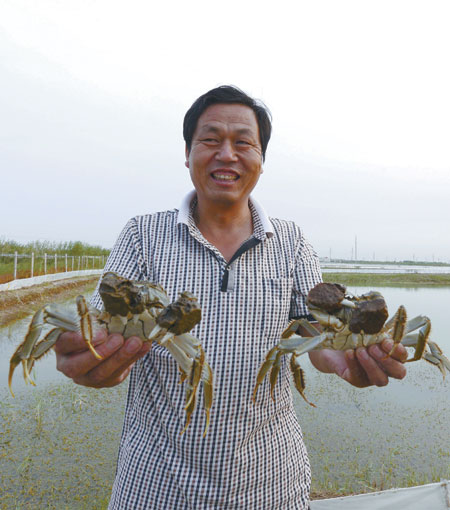Finding the green side of crabs
Updated: 2013-12-05 07:14
By Zhao Yinan (China Daily)
|
|||||||||||
Liu Yuanju and his wife closed their small rural restaurant in 2004 and started to raise crabs in a small pond in their backyard. Almost 10 years later, their business, in Dongying in East China's Shandong province, has expanded into a crab farm that can bring in 2.5 million yuan ($408,500) a year.
The hairy crabs the couple is raising are named after their furry claws, and they are among the Chinese people's favorite dishes. Usually available in the market in autumn, these crabs have reached prices of more than 100 yuan each.
With an annual output of about 5,000 kilograms, the crab farm of 6.7 hectares brings Liu more than twice the income he earned from the restaurant.
"The larger the crab, the higher the price," Liu says. "We took training lessons offered by the local government to learn the basic feeding for hairy crabs, such as the proportions of carbohydrates, fat and protein."
As one of the eco-friendly agricultural businesses gaining momentum in recent years, raising crabs is in line with the Dongying government's vision to develop its economy at less cost to the environment.
After being endorsed by the central government as an eco-efficient economic zone, Dongying has been searching for a route toward economic prosperity and ecological preservation.
The delicate balance between the two had been one of the questions challenging decision-makers in Dongying, says Xue Rongjian, director of the Yellow River Delta Eco-Efficient Economic Development Zone.
"In terms of agriculture, that means whatever projects we are planning to roll out, we have to consider if they are ecologically friendly - or, if they could potentially damage the ecological balance, whether that damage could be controlled."
Liu Baoyu, from the local agriculture bureau, says the cultivation of crabs, fungus and sea cucumbers could meet these requirements very well.
Primary products such as fungus are exempt from agricultural taxes and eligible for financial aid from the local government. By June, 12 companies and 46 rural co-operatives had been set up in Dongying to produce fungus.
Liu says the local fungus industry had reached a turning point. From producing general edible fungus, they are shifting toward the more profitable field of fungus for medicinal purposes.
One of the successful companies is Ronfun. Set up in 2007, Ronfun produces 80 tons of fungus every year and exports its products to Thailand, Singapore and other countries.
The company has just succeeded in cultivating a highly nutritious fungus called cordyceps militaris, which is widely used as a traditional Chinese medicine in Asian countries. Excessive exploitation of the wild fungus has damaged its habitat and led to a surge in its price. The market price of cordyceps militaris is about 600 yuan a kilogram, much higher than ordinary fungus.
Ronfun owes its success to researchers such as Fan Keming, who has devoted a decade to the cultivation of the rare fungus.
"Cordyceps militaris should gain popularity because of its ability to improve the immune system and even fight cancer," the doctor of microbiology says.
Yang Haijun, chief engineer at Ronfun, says that industrialized fungus production has clear advantages over growing fungus at rural households, where the quality is often subject to variations in sanitary conditions and cultivation skills.
As well as crabs and fungus, raising sea cucumbers is another eco-friendly business that the local government has been promoting.
Sea cucumbers were once believed to be only suitable for cultivation on the coastal reef of Liaoning province in Northeast China.
High profits and the nutritious aquatic species' minimal soil requirement have lured many people in Dongying, where the soil contains a high amount of salt and alkalis and where most farmers plant cotton for a small income.
|
Farmer Liu Yuanju is happy with this year's harvest at his crab farm in Dongying, Shandong province. Ju Chuanjiang / China Daily |
(China Daily 12/05/2013 page18)
Today's Top News
Dialogue 'key to relations'
China eyes high-level FTAs network
Cameron gets language right on weibo
Japan launches security council
Value-added tax reform expands
UK stays open for Chinese investors
Air zone 'beneficial to safety'
Yuan overtaking euro in trade
Hot Topics
Lunar probe , China growth forecasts, Emission rules get tougher, China seen through 'colored lens', International board,
Editor's Picks

|

|

|

|

|

|






